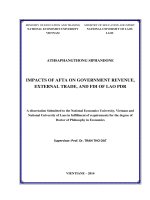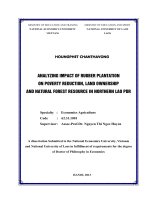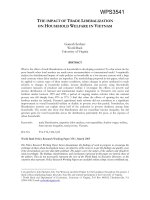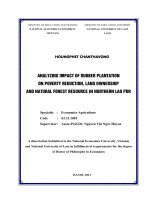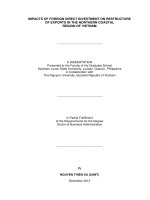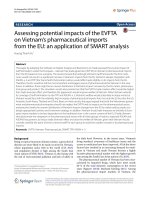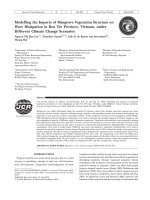Analyzing he Impacts of ASEAN trade Liberalization on Vietnams trading of Electronic Products
Bạn đang xem bản rút gọn của tài liệu. Xem và tải ngay bản đầy đủ của tài liệu tại đây (921.82 KB, 12 trang )
Analyzing the Impacts of ASEAN Trade Liberalization on
Vietnam’s Trading of Electronic Products
Nguyen Anh Thu
Tran Trung Duc
1 Introduction
During the last decades, globalization and economic integration have become the main trend of every
economy in the world, whether they differ from each other in terms of scale, development level or belong to
different political – social regimes. There have already been many international organizations and agreements
formed and pursuing the same goal, which is to build a common and fair market to improve trading between
countries and bring the greatest welfare for the members.
Vietnam has been implementing the integration including liberalizing trade and investment within the
framework of WTO agreements, ASEAN and other FTAs. Among different integration processes that Vietnam
is taking part in, ASEAN is the first and is always considered priority integration. ASEAN is moving forward
to the establishment of ASEAN Economic Community, one of the three pillars of ASEAN Community along
with ASEAN Political – Security Community and ASEAN Socio-Cultural Community at the end of 2015.
Among the 12 categories of goods and services that the AEC focuses on, electronic products are believed
to be the crucial commodity for countries as it raises great competition. In recent years, technology has been
changing at a speed of lightning to become more modern and functional. The demand for electric goods of
consumers is large and varied in daily life. Moreover, electric devices also contribute in industry, commerce,
medical purposes and so on. It is reasonable that the electronic industry plays an important role for whichever
country in the way to industrialization and modernization, especially for developing countries like Vietnam.
Vietnam is still falling behind some other ASEAN members on the field of electronics. That industry of
Vietnam still remains young and inexperienced. As the AEC is coming close, Vietnam is facing even more
difficulties playing on a fair ground with other countries, when trade barriers are eliminated. By using gravity
model with trade data from UN Comtrade database, the purpose of this paper is to capture the impact of
ASEAN integration process on the trade flows of Vietnamʼs electronic products. The next section provides an
overview of electronic products trading of Vietnam, while section three reviews related literature. The model
and results are discussed in section four, with the conclusion in section five.
* This article has been done under the research project QGT 13.22 “Assessing the economic integration process of
Vietnam in ASEAN and ASEAN + 3 from 2013 to 2015” with the support from Vietnam National University.
62
Yokohama Journal of Social Sciences, Vol. 19, No. 6
504
2002
2003
2004
2005
2006
2007
2008
2009
2010
2011
679,822,450
941,602,485
1,307,298,397
1,543,364,885
2,070,921,598
3,277,300,781
3,655,854,748
4,198,336,493
7,080,167,785
12,845,328,084
2012
2001
604,921,490
22,306,095,146
2000
572,104,000
Table 1 Export value of Vietnam domestically manufactured electronic products
(unit: USD)
Source: UN Comtrade
(unit: USD)
$3,000,000,000
$2,500,000,000
Japan
$2,000,000,000
USA
China
$1,500,000,000
Singapore
$1,000,000,000
Rep. of Korea
Malaysia
$500,000,000
$0
2005 2006 2007 2008 2009 2010 2011 2012
Source: UN
UN Comtrade
Source:
Comtrade
Figure 1 Export value of electronic products from Vietnam to six main partners
2 Vietnam s trade of electronic products
Before the year 1996, there had been no exports of electronic products from Vietnam. However,
nowadays, almost 50 countries including those around the area and in the world are importing electronic
products from Vietnam. Since 2005, the electronic industry has always been in the top 10 industries having the
highest export value in Vietnam. In 2012, the total export value of this industry was over 22 billion USD – a
sharp increase from merely 1.5 billion USD in 2005.
Currently, Vietnam has around 500 firms working on the field of electronic production. Meanwhile,
foreign (foreign direct invested - FDI) firms hold a crucial position in Vietnamʼs market, taking around 80%
of domestic market shares and 95% of the total export value. This feature well explains that the main export
markets of Vietnam are at the same time the main investors in Vietnam.
Figure 1 illustrates the total amount of electronics export value to six main partners of Vietnam over
Analyzing the Impacts of ASEAN Trade Liberalization on Vietnam’s Trading of Electronic Products Nguyen Anh Thu, Tran Trung Duc
505
63
(unit: USD)
25,000,000,000
20,000,000,000
15,000,000,000
10,000,000,000
5,000,000,000
0
2000 2001 2002 2003 2004 2005 2006 2007 2008 2009 2010 2011 2012
export
import
Source: UN Comtrade
Figure 2 Vietnam s import and export value of electronic products
a period of seven years. It is shown that Japan by far was the greatest importer of Vietnam, with the value
increased dramatically over years from around 800 million USD in 2005 to well under 2.5 billion USD in
2012. It was followed by the USA although there was a huge gap between export values to the two countries.
One significant thing is that since the beginning of 2011, export value of electric products to most partners
rocketed. The figures of Korea and Malaysia stayed at the bottom and only went up slightly to around 500
million USD in 2012.
Despite the fact that electronic commodities are among the 10 most exported goods from Vietnam, whose
export value remained high and climbed up remarkably especially during the late few years, the import value
of electronics tended to stay at a higher level. Most noticeable was the trend in 2007 where export value
almost leveled out around 400 million USD while import value continued to go up to almost twice time as
high. This might not be resulted from the free trade agreements but was rather explained by the global crisis
in finance during the year 2007. As big countries like the USA, Japan, China or the European countries had
their economies damaged, their needs for imported goods fell down as well affecting the export value of
Vietnam since they are all important partners. However, Vietnam, suffering less damage from the crisis, could
still maintain its consumption. Therefore import value of electronics into Vietnam kept going up through the
difficult time, leading to the unbalance in the trade volumes. It was not until the year 2010 that export value
experienced a recover and rose exponentially to catch up with import value in 2012.
The electronic industry of Vietnam has been staying at the early stage of development since firms in
Vietnam mostly specialize in assembling and manufacturing products while invest modestly on producing
components and intermediaries. Consequently, besides the final goods Vietnam imports from other countries,
there have also been a massive amount of components that it had to import as well. Although the intermediary
industry in Vietnam is developing as the encouragement of the government, Vietnam still has to depend
506
64
Yokohama Journal of Social Sciences, Vol. 19, No. 6
greatly on foreign countries. As a result, not only Vietnamʼs domestic firms producing electronic products
face difficulties but it is also challenging for firms providing intermediaries to compete in this market. The
drawback on intermediary industry making Vietnam electronic industry depend greatly on imports, which
leads to low value added of its exports.
3 Literature review
Assessing the impacts of trade liberalization is common topic among economists. Many of them tried to
analyze the impacts of liberalizing trade on social welfare, economic reconstruction, the scale and potential
of industries as well as many other micro and macro indicators of the economy. Among them, one of the
commonly used methodology to assess the impact on trade flow is the gravity model.
Dan Wenting and Yang Jie (2006) used the gravity model in quantitative analysis of China-ASEAN
trade, using 2000‒2004 panel data to establish the basic gravity model and the expansive gravity model in
order to study the main factors that have an impact on China-ASEAN bilateral trade volume. Rahman et al.
(2006) investigates the trade creation and trade diversion effects of a number of RTAs, with special focus on
the SAFTA, by using a gravity model. Apart from the traditional gravity variables, the model is augmented
by some other import variables (e.g. bilateral exchange rate, bilateral free trade agreement). The study finds
significant intra-bloc export creation in SAFTA; however, at the same time there is evidence of net export
diversion in the SAFTA. Bangladesh, India and Pakistan are expected to gain from joining the RTA, while
Nepal, Maldives and Sri Lanka are likely to be negatively affected.
In Batra (2006), an augmented gravity model equation has been used to analyze the world trade flows
using a sample of 146 countries. The coefficients thus obtained are then used to predict trade potential for
India. The results show that all three traditional “gravity” effects are intuitively reasonable and statistically
significant. Historical and cultural similarities also impact positively upon bilateral trade. As concerns Indiaʼs
trade potential, the model shows that there is tremendous potential with China and trade can be more than
double if barriers and constraints are removed. The research also indicates a huge potential with Pakistan.
Cheong (2008) evaluates changes in trade patterns of ASEAN at the Harmonized System (HS) six-digit level
in the period 2001 to 2003. The estimates show that, in general, ASEAN preferential margins had a tradecreating effect at the product level; the majority of ASEAN countries benefited significantly from this trade
creation. These results suggest that ASEAN trade liberalization in the early 2000s had positive welfare effects.
Sheng et al. (2012), uses an extended gravity model to shed light on the impact of the free trade area
agreement between the ASEAN and the Peopleʼs Republic of China (PRC) on the membersʼ trade flows
and trade patterns. Results from the extended gravity model show that the free trade agreement leads to
substantially higher bilateral trade between ASEAN and the PRC, more than what a conventional gravity
model predicts. The increase is concentrated in the ASEAN countries with stronger industrial linkages with the
PRC.
Contributing to the study of international trade and integration, there have also been some researches
using gravity model to assess Vietnamʼs trade liberalization. Thai Tri Do (2006) examines the bilateral trade
between Vietnam and 23 European countries based on Gravity model and panel data for 1993 to 2004.
Estimates indicate that economic size, market size and real exchange rate of Vietnam and 23 European
countries play major role in bilateral trade between Vietnam and these countries. Nguyen Thi Ha Trang et
Analyzing the Impacts of ASEAN Trade Liberalization on Vietnam’s Trading of Electronic Products Nguyen Anh Thu, Tran Trung Duc
507
65
al. (2011) shows that the fast GDP growth of Vietnam, the large population of importing countries, the wide
economic gap between Vietnam and the importing countries, the depreciation of domestic currency, the free
trade agreements that Vietnam signed and the shared border with the importing countries contribute to the
increase of Vietnamʼs export of all product groups. In contrast, the GDP of importing countries and population
of Vietnam have no clear impacts on the export of any product groups. Dinh Thi Thanh Binh et al. (2012),
applies gravity model in order to analyze bilateral trade activities between Vietnam and 60 countries from
2000 to 2010. The estimated results reveal that economic size of Vietnam, economic size and market size of
foreign partners, distance and culture have huge effects on bilateral trade flows between Vietnam and these 60
countries.
In summary, the gravity model is a key tool for researchers interested in the effects of trade-related
policies. The recent Gravity model includes a great number of variables, beyond those such as tariffs, which
are imposed at the border, to cover behind-the-border barriers as well. Moreover, the gravity model is applied
not only to general trade flows, but also to different segmented sectors.
4 Methodology and estimated results
Model
Built on the idea of Gravity theory by Newton, the Gravity model demonstrates that trade volume
between two particular countries have the positive correlation with the scale of economy in each countries and
negative one with the distance between them.
In order to assess the impacts of ASEAN trade liberalization on Vietnamʼs trade flows of electronic
products, the gravity model in this paper follows the one used by Nguyen Anh Thu (2012), which takes the
following form:
��
��
��
��
��
��
��
��
In which:
Mij is the trade value between country (i) and country (j) (in terms of export/import value).
G is constant
Yi, Yj are the economic scales of country (i) and country (j). In general Y is measured in Gross Domestic
Products (GDP).
GDP/P: Gross domestic product per capita.
Dij is the distance between country (i) and country (j) (which represents the cost of trading between the
two countries).
t implies years.
Within the equation, k takes the value from 1 to 5 which is equivalent to free trade agreements AFTA,
ACFTA, AKFTA, AJCEP and VJEPA respectively. These dummy variables take the value of 1 if both importers
and exporters are participants in that agreement in year t, and the value of 0 in other cases. Consequently the
Yokohama Journal of Social Sciences, Vol. 19, No. 6
508
66
Table 2 Defined year in which each FTAs went into effect
FTAs
AFTA
ACFTA
AKFTA
AJCEP
VJEPA
Year
2006
2006
2007
2008
2009
value of dummy variable for each FTAs depends on the mark of time when that FTA was put through and went
into effect. As for the AFTA, although Vietnam became a member of ASEAN since 1995, within this paper
we only focus on the impacts of the AEC. In order to do so, we take the year in which the blueprint of AEC,
including all of its elements and characteristics pursuing the establishment of AEC in 2015, was introduced
and committed by the member countries (followed by adjustments in policies in the next years, such as the
change from the ASEAN Free Trade Area-Common Effective Preferential Tariff to the ASEAN Trade in Goods
Agreement in 2008), which was the year of 2006.
The model is applied on Vietnamʼs export and import of electronic products with partners (in which j
denotes Vietnam and i represents the partner country).
Data
The data on trade volume in electronic products between Vietnam and 47 partner countries over the period
of 13 years (2000–2012) is collected from UN Comtrade. The partners spread on a global scale geographically
and in terms of trade flows with Vietnam. As we use the real GDP in this model, it is necessary to deflate the
left hand-side of the model, the trade value whether it is import value or export value. Therefore the deflated
trade value is conducted in the formula:
Deflated trade value = (Nominal trade value/Consumer price index) ⊗ 100
As the nominal trade values are reported by Vietnam, we use Vietnamʼs annual consumer price index
provided by World Bank (which sets the year of 2010 as base year).
The real GDP and GDP per capita used in this model are calculated following the formula:
Real GDP = (nominal GDP/GDP deflator) ⊗ 100
Real GDP per capita = (nominal GDP per capita/GDP deflator) ⊗ 100
In which all the nominal values are gathered from the website of World Bank while the GDP deflator is
provided by the website of International Monetary Fund. According to the IMF, the GDP deflator is countryspecific, meaning it was conducted separately in each nations and do not equal 100 in the specified base year
(each nation set their own base year and there were differences in original data in fiscal year). However, this
does not affect the result of the model since, within this model, we only capture the movements and volume of
changes in GDP deflator of each countries over the estimated period of time, not its absolute values.
Distance between countries is the geographical gap between the capital cities of the two countries in the
partnership, conducted by the website “Centre dʼ Etudes Prospectives et dʼInformations Internationales” (CEPII).
Estimated results
Export model
It is clearly demonstrated from the table that real GDP and real GDP per capita in both countries have a
strong connection to the export value of electronic products from Vietnam to its partner. The GDP of the two
Analyzing the Impacts of ASEAN Trade Liberalization on Vietnam’s Trading of Electronic Products Nguyen Anh Thu, Tran Trung Duc
509
67
Table 3 Estimated results from export model
Coefficient
Std. Error
T-Statistic
Prob.
C
-323.1442*
30.87393
-10.46657
0.0000
LOG(GDPi)
1.009185*
0.065927
15.30756
0.0000
Variables
LOG(GDPvn)
16.70496*
1.892135
8.828630
0.0000
LOG(GDPPCi)
0.500406*
0.151525
3.302457
0.0010
LOG(GDPPCvn)
-12.37705*
2.693345
-4.595419
0.0000
LOG(Incomegap)
-0.441550*
0.112899
-3.911012
0.0001
LOG(Dist)
-2.056969*
0.121322
-16.95457
0.0000
AFTA
1.811531**
0.940629
1.925872
0.0546
ACFTA
-1.336528**
0.754578
-1.771224
0.0771
AJCEP
-0.235797
0.616671
-0.382371
0.7023
AKFTA
-0.344310
0.597680
-0.576078
0.5648
VJEPA
0.331333
1.125764
0.294318
0.7686
R-square: 0.572056
Adjusted R-square: 0.563841
(*), (**) equivalent to the signiicant level of 5% and 10% respectively
countries can illustrate the development of industry in each country. Taking a positive coefficient of 1, GDP
of partner countries shows that Vietnam tend to export electronic products to big and medium size economies.
Meanwhile, the coefficient of Vietnamʼs GDP stays at a very high level of around 16.7 that can be explained
that as the economy of Vietnam becomes bigger, more products are produced to satisfy both domestic and
foreign demand, leading to an increasing export value.
By contrast, real GDP per capita of Vietnam takes a very low negative coefficient value of minus 12.37,
telling that the increase in Vietnam individual citizenʼs income leads to a greater size of domestic market as the
demand and consumption within the country go up as well due to the income effect. That, along with many
effective policies and campaigns from Vietnamʼs government to promote domestic products and motivate
Vietnamʼs citizens to use Vietnamese products, helps increase the demand for every category of products
including this commodity and consequently reduce the amount of exports.
Meanwhile, the estimation of income gap and distance seems to prove the expectation of the Gravity
model, both have the negative correlation with export value. Holding every other factor constant, with every
rise of 1% in the income gap, the export value experiences an average drop of approximately 0.44%. While
distance has a stronger effect as it decreases trade by an average 2% for each 1% it climbs up. This proves that
trading is more likely to happen between countries with close development level and distance.
Through the result of the model, it seems that only the AFTA and the ACFTA have the impacts on
Vietnamʼs export value of electronic products, but the effects from these two agreements are opposite to each
other as the coefficients of them take the value of 1.81 and minus 1.33 respectively. As the main objective of
taking part in an FTA is to enhance trade partnership between countries as discussed in previous parts, it is
easy to understand why AFTA can boost the value export of member countries including Vietnam. Not only
does the AFTA cause trade creation between member countries due to the elimination of trade barriers (taxes,
68
510
Yokohama Journal of Social Sciences, Vol. 19, No. 6
tariffs, non-tariff barriers, etc.), making them establish greater trading ties between themselves, but it also
leads to trade diversion which shifts trading with non-members of ASEAN to trading with those participants
of the AFTA. However, that theory does not hold completely true to the trade agreement between China and
the ASEAN. The ACFTA are introduced to improve total welfare and trading of the whole area (the ASEAN
and China). The reasons why Vietnamʼs export value does not seem to be supported by ACFTA will be further
discussed in the next section. At the confidence level of either 5% or 10%, AJCEP, AKFTA and VJEPA are
yet to have such noticeable influences on Vietnamʼs export value of electronic products. This is similar to the
findings of some other studies (Lee and Plummer, 2011; Nguyen Anh Thu, 2012).
Import model
Similarly to the export model, in this import model, at the confidence level of 5%, GDP of exporter (the
partner country of Vietnam) have a positive correlation with the import value (1.25).
Income gap and distance still take the negative value of minus 0.61 and minus 2.05, proving that imports
tends to reduce as the gap between the two countries go up economically and geographically. This is suitable
to the expectation of the Gravity model theory.
Surprisingly, while AFTA has a positive effect on Vietnamʼs exportation of electronic products, it seems to
reduce the import value in the same category of commodity (the coefficient is minus 1.4 at the significant level
of 10%). This is, in fact, illustrated in Figure 2 of this study where export value went up along with the import
value but with a higher speed to catch up import value in 2012. This may prove that with the integration within
ASEAN, the intermediary industry for electronic products has been improved, supporting the manufacturing
industry. As the quantity of domestic electronic goods rose over the late few years, not only did Vietnam satisfy
the domestic needs but it also made a great effort in switching from importing to exporting. It also suggests
that the quality of domestically produced electronic goods has been enhanced and this, along with many
promoting policies from the government, helps raise the trust and loyalty of customers in Vietnamʼs domestic
goods. It is believed that the domestic manufacturing firms have a lot of rooms to grow further in the future.
It draws attention when ACFTA decreases the export value but helps increase the import value of electric
products in Vietnam (taking the coefficient of 1.31 in the import model). As mentioned above, the impacts of a
free trade agreement may not be identical among the members. In this situation, it can be explained that, of the
two countries, China has the comparative advantages in producing electronic products. Proving to have a large
force of labor at low price, more advanced development background than that of Vietnam, China has earned a
competitiveness edge to overwhelm the market with its products. Products made from China are not expensive
which are affordable by all classes of people in the society. At the same time, they are useful, functional and
up to date with the development of technology as well as changes in consumersʼ tastes. Consequently, China
has become a large exporter in the global market, taking away market shares from Vietnamʼs exporters while
Vietnamʼs consumers keep purchasing and consuming products imported from this big producer.
Despite having no impacts on the export value of Vietnamʼs electronic products, the AJCEP tends to
have a negative influence on the import value (minus 0.88). Although Vietnam and Japan have remained
in partnership for decades and therefore the VJEPA does not affect trade between them significantly, the
agreement between Japan and the ASEAN allows Japanese enterprises to broaden their business in other
countries those are more potential and advanced in technology, as well as management skills, than Vietnam,
such as Malaysia, Singapore, etc. That might lead to the shift of focus in trading Japanese electronic products
Analyzing the Impacts of ASEAN Trade Liberalization on Vietnam’s Trading of Electronic Products Nguyen Anh Thu, Tran Trung Duc
511
69
Table 4 Estimated results from import model
Coefficient
Std. Error
t-Statistic
Prob.
C
-7.297093
28.02528
-0.260375
0.7947
LOG(GDPi)
1.251431*
0.058793
21.28542
0.0000
Variable
LOG(GDPvn)
-0.339478
1.713569
-0.198112
0.8430
LOG(GDPPCi)
0.925789*
0.170709
5.423189
0.0000
LOG(GDPPCvn)
2.572149
2.436520
1.055665
0.2916
LOG(Incomegap)
-0.612003*
0.133475
-4.585139
0.0000
LOG(Dist)
-2.046722*
0.112439
-18.20302
0.0000
AFTA
-1.400218**
0.814407
-1.719309
0.0862
ACFTA
1.309336*
0.662499
1.976358
0.0486
AJCEP
-0.878630**
0.532610
-1.649669
0.0996
AKFTA
1.205032*
0.515817
2.336160
0.0199
VJEPA
0.767078
0.973055
0.788319
0.4309
R-square: 0.649480
Adjusted R-square: 0.642079
(*), (**) equivalent to the signiicant level of 5% and 10% respectively
to other countries in the area, which consequently brings down the quantity of electronic goods imported to
Vietnam.
The AKFTA does not have significant impact on exports of Vietnam but has positive impact on import
with the coefficient of 1.21. This means the free trade agreement benefits Korean electronic-firms by giving
them more incentives and fewer trade barriers so they can jump into the ASEAN market. It is true that in recent
years, Korean electronic products have been used more widely, especially mobile phones and civil devices
(some of the famous names are Samsung Electronics, Sky Electronics, LG Electronics, SY Telecom, etc.).
Korea also made a huge amount of investments to countries within the region including Vietnam, thus boosting
the imports of intermediate products to serve production requirement.
5 Conclusion
Higher GDP in Vietnam and the partner countries lead to the increase in both export and import value
of electronic products. As the total output of a countries rises, there will not be enough goods to satisfy the
domestic market and also inventories for exporting to other countries. Vietnam tends to trade with medium
and big size partners as the higher its partnersʼ GDP is, the more trade value is created. The GDP per capita of
Vietnam has a great influence on export value. As real income of individual citizens goes up, it leads to higher
demand for the products and the domestic market gets bigger. Consequently, smaller quantity of goods is
exported. Huge income gap and long distance between partners discourage both export and import.
The AFTA has a positive influence on export value of Vietnam while having a negative one on its import
value. The free trade agreements of ASEAN boost trade creation between member countries while diverse
trade from non-members to those within the organization, due to many incentives related to trade barriers. As
Vietnam electronic industry has been improving in recent years, on one hand, it becomes able to provides more
Yokohama Journal of Social Sciences, Vol. 19, No. 6
512
70
goods for the foreign market and enhance exportation. On the other hand, the demand from domestic market
went up as well since more consumers choose to use domestically manufactured devices instead of those
imported aboard, which discourages importing.
China is a strong competitor of Vietnam in electronic market since the ACFTA was established. Although
electronic products from China are sold at very low prices, they are functional and catch up fast with the trends
and needs of consumers as well as the fast development of technology. As a result, goods made in China are
still popular in the global market, driving off exportation from Vietnam while still account for a great share of
Vietnamʼs domestic market.
The findings of this paper might have some implications for developing electronic industry in Vietnam.
Firstly, developing intermediary electronic industry is a key issue since it is considered as an important factor
for developing the electronic industry. This will help reduce the cost of importing components, create higher
value-added for Vietnamese products. Moreover, it is important to classify the proper products for Vietnamʼs
electronic industry, complete the policies and structure in order to form the effective production network in
Vietnam, which is linked to the region and to the world.
Abbreviations
WTO
World Trade Organization
ASEAN
Association of South East Asian Nations
FTAs
Free Trade Agreements
AEC
ASEAN Economic Community
RTAs
Regional Trade Agreements
SAFTA
South America Free Trade Agreement
AFTA
ASEAN Free Trade Agreement
ACFTA
ASEAN – China Free Trade Agreement
AKFTA
ASEAN – Korea Free Trade Agreement
AJCEP
ASEAN – Japan Comprehensive Economic Partnership
VJEPA
Vietnam Japan Economic Partnership Agreement
References
Batra, A. (2006). Indiaʼs global trade potential: The gravity model approach. Global Economic Review, 35(3), 327
361.
Cheong, D. (2008). The Effects of AFTA: A Disaggregated Analysis. Johns Hopkins University.
Dinh Thi Thanh Binh, Nguyen Viet Duong, and Hoang Manh Cuong (2012). Applying Gravity model to analyze trade
activities of Vietnam, Foreign trade University.
Lee, H. and Plummer, M. G. (2011). Assessing the Impact of the ASEAN Economic Community. OSIPP Discussion
Paper: DP-2011-E-002.
Nguyen Anh Thu (2012). Assessing the impact of Vietnamʼs integration under AFTA and VJEPA on Vietnamʼs trade
flows, Gravity model approach. Yokohama Journal of Social Sciences, Vol. 17, No. 2, pp. 137 148.
Nguyen Thi Ha Trang, Nguyen Thi Thanh Tam, and Vu Hoang Nam. (2011). An inquiry into the determinants of
Vietnamese product export, DEPOCEN working paper series, No. 08.
Rahman, M., Shadat, W. B., & Das, N. C. (2006). Trade potential in SAFTA: An application of augmented gravity
model. CPD Occasional Paper Series, 61.
Analyzing the Impacts of ASEAN Trade Liberalization on Vietnam’s Trading of Electronic Products Nguyen Anh Thu, Tran Trung Duc
513
71
Sheng, Y., Tang, H. C., & Xu, X. (2012). The Impact of ACFTA on People’s Republic of China-ASEAN Trade:
Estimates Based on an Extended Gravity Model for Component Trade (No. 99). Asian Development Bank.
Thai Tri Do (2006), A gravity model for trade between Vietnam and twenty-three European countries. Department of
Economics and Society, Dalarna University, Sweden.
Wenting, D. and Jie, Y. (2006). Gravity Model in China and ASEAN Trade Real Diagnosis Analysis. Asia-Paciic
Economic Review, 2006 (6).
Nguyen Anh Thu, Lecturer, University of Economics and Business, Vietnam National University, Hanoi
Tran, Trung Duc, University of Economics and Business, Vietnam National University, Hanoi
